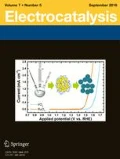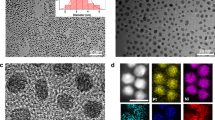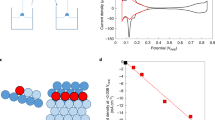Abstract
Using periodic, self-consistent density functional theory (GGA-PW91) calculations, a series of onion-structured metal alloys have been investigated for their catalytic performance towards the oxygen reduction reaction (ORR). The onion-structures consist of a varying number of atomic layers of one or two metals each, pseudomorphically deposited on top of one another to form the overall structure. All catalysts studied feature a Pt overlayer, and often consist of at least one Pd layer below the surface. Three distinct ORR mechanisms were analyzed on the close-packed facets of all the structures considered. These mechanisms include a direct route of O2 dissociation and two hydrogen-assisted routes of O–O bond-breaking in peroxyl (OOH) and in hydrogen peroxide (HOOH) intermediates. A thermochemical analysis of the elementary steps provides information on the operating potential, and thereby energy efficiency of each electrocatalyst. A Sabatier analysis of catalytic activity based on thermochemistry of proton/electron transfer steps and activation energy barrier for O–O bond-breaking steps leads to a “volcano” relation between the surfaces’ activity and the binding energy of O. Several of the onion-structured alloys studied here show promise for achieving energy efficiency higher than that of Pt, by being active at potentials higher than the operating potential of Pt. Furthermore, some have at least as good activity as pure Pt at that operating potential. Thus, a number of the onion-structured alloys studied here are promising as cathode electrocatalysts in proton exchange membrane fuel cells.





Similar content being viewed by others
References
J.L. Zhang, M.B. Vukmirovic, Y. Xu, M. Mavrikakis, R.R. Adzic, Controlling the catalytic activity of platinum-monolayer electrocatalysts for oxygen reduction with different substrates. Angew. Chem. Int. Ed. 44(14), 2132–2135 (2005)
M.B. Vukmirovic, J. Zhang, K. Sasaki, A.U. Nilekar, F. Uribe, M. Mavrikakis, R.R. Adzic, Platinum monolayer electrocatalysts for oxygen reduction. Electrochim. Acta 52(6), 2257–2263 (2007)
R.R. Adzic, J.X. Wang, Configuration and site of O2 adsorption on the Pt(111) electrode surface. J. Phys. Chem. B 102(45), 8988–8993 (1998)
J.K. Nørskov, J. Rossmeisl, A. Logadottir, L. Lindqvist, J.R. Kitchin, T. Bligaard, H. Jonsson, Origin of the overpotential for oxygen reduction at a fuel-cell cathode. J. Phys. Chem. B 108(46), 17886–17892 (2004)
J.X. Wang, N.M. Markovic, R.R. Adzic, Kinetic analysis of oxygen reduction on Pt(111) in acid solutions: Intrinsic kinetic parameters and anion adsorption effects. J. Phys. Chem. B 108(13), 4127–4133 (2004)
J. Zhang, Y. Mo, M.B. Vukmirovic, R. Klie, K. Sasaki, R.R. Adzic, Platinum monolayer electrocatalysts for O2 reduction: Pt monolayer on Pd(111) and on carbon-supported Pd nanoparticles. J. Phys. Chem. B 108(30), 10955–10964 (2004)
R. Bashyam, P. Zelenay, A class of non-precious metal composite catalysts for fuel cells. Nature 443(7107), 63–66 (2006)
V.R. Stamenkovic, B. Fowler, B.S. Mun, G.F. Wang, P.N. Ross, C.A. Lucas, N.M. Markovic, Improved oxygen reduction activity on Pt3Ni(111) via increased surface site availability. Science 315(5811), 493–497 (2007)
J. Zhang, K. Sasaki, E. Sutter, R.R. Adzic, Stabilization of platinum oxygen-reduction electrocatalysts using gold clusters. Science 315(5809), 220–222 (2007)
A.U. Nilekar, Y. Xu, J.L. Zhang, M.B. Vukmirovic, K. Sasaki, R.R. Adzic, M. Mavrikakis, Bimetallic and ternary alloys for improved oxygen reduction catalysis. Top. Catal. 46(3–4), 276–284 (2007)
M.H. Shao, K. Sasaki, P. Liu, R.R. Adzic, Pd3Fe and Pt monolayer-modified Pd3Fe electrocatalysts for oxygen reduction. Z. Phys Chem. Int. J. Res. Phys. Chem. Chem. Phys. 221(9), 1175–1190 (2007)
C.T. Campbell, Bimetallic surface-chemistry. Annu. Rev. Phys. Chem. 41, 775–837 (1990)
N.M. Markovic, P.N. Ross, Surface science studies of model fuel cell electrocatalysts. Surf. Sci. Rep. 45(4–6), 121–229 (2002)
J. Greeley, M. Mavrikakis, Alloy catalysts designed from first principles. Nat. Mater. 3(11), 810–815 (2004)
T. Bligaard, J.K. Nørskov, S. Dahl, J. Matthiesen, C.H. Christensen, J. Sehested, The Bronsted–Evans–Polanyi relation and the volcano curve in heterogeneous catalysis. J. Catal. 224(1), 206–217 (2004)
A.U. Nilekar, M. Mavrikakis, Improved oxygen reduction reactivity of platinum monolayers on transition metal surfaces. Surf. Sci. 602(14), L89–L94 (2008)
W.P. Zhou, X.F. Yang, M.B. Vukmirovic, B.E. Koel, J. Jiao, G.W. Peng, M. Mavrikakis, R.R. Adzic, Improving electrocatalysts for O-2 reduction by fine-tuning the Pt-support interaction: Pt monolayer on the surfaces of a Pd3Fe(111) single-crystal alloy. J. Am. Chem. Soc. 131(35), 12755–12762 (2009)
V.R. Stamenkovic, B.S. Mun, K.J.J. Mayrhofer, P.N. Ross, N.M. Markovic, Effect of surface composition on electronic structure, stability, and electrocatalytic properties of Pt-transition metal alloys: Pt-skin versus Pt-skeleton surfaces. J. Am. Chem. Soc. 128(27), 8813–8819 (2006)
P. Hirunsit, P.B. Balbuena, Stability of Pt monolayers on Ir-Co Cores with and without a Pd interlayer. J. Phys. Chem. C 114(30), 13055–13060 (2010)
J. Greeley, J.K. Nørskov, Electrochemical dissolution of surface alloys in acids: thermodynamic trends from first-principles calculations. Electrochim. Acta 52(19), 5829–5836 (2007)
P. Mani, R. Srivastava, P. Strasser, Dealloyed Pt-Cu core-shell nanoparticle electrocatalysts for use in PEM fuel cell cathodes. J. Phys. Chem. C 112(7), 2770–2778 (2008)
G.E. Ramirez-Caballero, Y.G. Ma, R. Callejas-Tovar, P.B. Balbuena, Surface segregation and stability of core-shell alloy catalysts for oxygen reduction in acid medium. Phys. Chem. Chem. Phys. 12(9), 2209–2218 (2010)
S. Alayoglu, A.U. Nilekar, M. Mavrikakis, B. Eichhorn, Ru-Pt core-shell nanoparticles for preferential oxidation of carbon monoxide in hydrogen. Nat. Mater. 7(4), 333–338 (2008)
L. Grabow, Y. Xu, M. Mavrikakis, Lattice strain effects on CO oxidation on Pt(111). Phys. Chem. Chem. Phys. 8(29), 3369–3374 (2006)
M. Mavrikakis, B. Hammer, J.K. Nørskov, Effect of strain on the reactivity of metal surfaces. Phys. Rev. Lett. 81(13), 2819–2822 (1998)
T. Bligaard, J.K. Nørskov, Ligand effects in heterogeneous catalysis and electrochemistry. Electrochim. Acta 52(18), 5512–5516 (2007)
P. Liu, J.K. Nørskov, Ligand and ensemble effects in adsorption on alloy surfaces. Phys. Chem. Chem. Phys. 3(17), 3814–3818 (2001)
F. Abild-Pedersen, J. Greeley, F. Studt, J. Rossmeisl, T.R. Munter, P.G. Moses, E. Skulason, T. Bligaard, J.K. Nørskov, Scaling properties of adsorption energies for hydrogen-containing molecules on transition-metal surfaces. Phys. Rev. Lett. 99(1), 016105 (2007)
J. Cheng, P. Hu, P. Ellis, S. French, G. Kelly, C.M. Lok, Bronsted–Evans–Polanyi relation of multistep reactions and volcano curve in heterogeneous catalysis. J. Phys. Chem. C 112(5), 1308–1311 (2008)
J.K. Nørskov, T. Bligaard, A. Logadottir, S. Bahn, L.B. Hansen, M. Bollinger, H. Bengaard, B. Hammer, Z. Sljivancanin, M. Mavrikakis, Y. Xu, S. Dahl, C.J.H. Jacobsen, Universality in heterogeneous catalysis. J. Catal. 209(2), 275–278 (2002)
M. Boudart, Kinetics of chemical processes (Prentice-Hall, Englewood, Cliffs, 1968)
D. Vanderbilt, Soft self-consistent pseudopotentials in a generalized eigenvalue formalism. Phys. Rev. B 41(11), 7892–7895 (1990)
B. Hammer, L.B. Hansen, J.K. Nørskov, Improved adsorption energetics within density-functional theory using revised Perdew–Burke–Ernzerhof functionals. Phys. Rev. B 59(11), 7413–7421 (1999)
J. Greeley, J.K. Nørskov, M. Mavrikakis, Electronic structure and catalysis on metal surfaces. Annu. Rev. Phys. Chem. 53, 319–348 (2002)
D.J. Chadi, M.L. Cohen, Special points in Brillouin zone. Phys. Rev. B 8(12), 5747–5753 (1973)
P. Ferrin, A.U. Nilekar, J. Greeley, M. Mavrikakis, J. Rossmeisl, Reactivity descriptors for direct methanol fuel cell anode catalysts. Surf. Sci. 602(21), 3424–3431 (2008)
J. Greeley, M. Mavrikakis, A first-principles study of surface and subsurface H on and in Ni(111): diffusional properties and coverage-dependent behavior. Surf. Sci. 540(2–3), 215–229 (2003)
G. Henkelman, B.P. Uberuaga, H. Jonsson, A climbing image nudged elastic band method for finding saddle points and minimum energy paths. J. Chem. Phys. 113(22), 9901–9904 (2000)
N.W. Ashcroft, N.D. Mermin, Solid State Physics (Brooks Cole, 1976)
W.B. Pearson, Handbook of lattice spacings and structures of metals and alloys
Because of well-known errors of DFT-GGA with the energetics of gas phase species, the calculated equilibrium potential at 298 K is 1.03 V
M.T.M. Koper, Thermodynamic theory of multi-electron transfer reactions: implications for electrocatalysis. J. Electroanal. Chem. 660(2), 254–260 (2011)
J.L. Zhang, M.B. Vukmirovic, K. Sasaki, A.U. Nilekar, M. Mavrikakis, R.R. Adzic, Mixed-metal Pt monolayer electrocatalysts for enhanced oxygen reduction kinetics. J. Am. Chem. Soc. 127(36), 12480–12481 (2005)
J. Greeley, J.K. Nørskov, Combinatorial density functional theory-based screening of surface alloys for the oxygen reduction reaction. J. Phys. Chem. C 113(12), 4932–4939 (2009)
J. Greeley, I.E.L. Stephens, A.S. Bondarenko, T.P. Johansson, H.A. Hansen, T.F. Jaramillo, J. Rossmeisl, I. Chorkendorff, J.K. Nørskov, Alloys of platinum and early transition metals as oxygen reduction electrocatalysts. Nat. Chem. 1(7), 552–556 (2009)
S.L. Knupp, M.B. Vukmirovic, P. Haldar, J.A. Herron, M. Mavrikakis, R.A. Adzic, Platinum monolayer electrocatalysts for O2 reduction: Pt monolayer on carbon-supported PdIr. Electrocatalysis 1(4), 213–223 (2010)
Acknowledgments
JH, JJ, KH, GP, and MM dedicate this paper to the landmark occasion of the 70th birthday of Dr. Radoslav R. Adzic. They all feel privileged to have had the opportunity to collaborate with him and be inspired by his influential ideas in the field of electrocatalysis, and wish him the very best on his birthday. Work at UW-Madison was supported by DOE-BES, Division of Chemical Sciences. JAH thanks Air Products & Chemicals, Inc. for a graduate fellowship. JJ thanks Drs. A. U. Nilekar and P. A. Ferrin for help at the initial phase of her work in this project. The computational work was performed in part using supercomputing resources from the following institutions: EMSL, a National scientific user facility at Pacific Northwest National Laboratory (PNNL); the Center for Nanoscale Materials at Argonne National Laboratory (ANL); the National Center for Computational Sciences at Oak Ridge National Laboratory (ORNL); and the National Energy Research Scientific Computing Center (NERSC). EMSL is sponsored by the Department of Energy’s Office of Biological and Environmental Research located at PNNL. CNM, NCCS, and ORNL are supported by the U.S. Department of Energy, Office of Science, under contracts DE-AC02-06CH11357, DEAC05-00OR22725, and DE-AC02-05CH11231, respectively.
Author information
Authors and Affiliations
Corresponding author
Additional information
Jeffrey A. Herron and Jiao Jiao contributed equally to this paper.
Rights and permissions
About this article
Cite this article
Herron, J.A., Jiao, J., Hahn, K. et al. Oxygen Reduction Reaction on Platinum-Terminated “Onion-structured” Alloy Catalysts. Electrocatalysis 3, 192–202 (2012). https://doi.org/10.1007/s12678-012-0087-0
Published:
Issue Date:
DOI: https://doi.org/10.1007/s12678-012-0087-0




